CBSE Class 10 Syllabus 2020-2021
CBSE Class 10 Syllabus 2020-21 All subject - Free PDF Download
CBSE Class 10 Syllabus - COVID-19 has impacted our lives along with studies, businesses, and economies, globally. We from 10yearsquestionpaper hope you and your family are doing well and staying safe during these challenging times. Here we are providing the syllabus which has been uploaded on the official site of CBSE cbseacademic.nic.in for the current academic session, 2020-2021. Due to the government’s order classes in school for the new academic session are not functional, we recommend the students to use their time effectively and start preparing for their board exams. CBSE syllabus for class 10th will allow students to plan their journey for achieving success along with scoring good grades. The link to download the subject-wise syllabus for all subject is provided below.
CBSE Class 10 Syllabus 2020-21 Download PDF
*Note: The annual board examination for CBSE class 10 will be of 80 marks, with a duration of three hours. There will be an internal assessment of 20 Marks.

Mathematics Syllabus for CBSE Class 10
The syllabus for class 10th CBSE Maths has been released on the official site of CBSE for the session 2020-2021. Students are advised to check the weightage of each unit and prepare accordingly.
UNIT I
Number Systems
Marks 06
1. Real Numbers (15 Periods) Euclid’s division lemma, Fundamental Theorem of Arithmetic - statements after reviewing work done earlier and after illustrating and motivating through examples, Proofs of irrationality ofDecimal representation of rational numbers in terms of terminating/non-terminating recurring decimals.
UNIT II
Algebra
Marks 20
1. Polynomials (7 Periods) Zeros of a polynomial. Relationship between zeros and coefficients of quadratic polynomials. Statement and simple problems on division algorithm for polynomials with real coefficients.
2. Pair of Linear Equations in Two Variables (15 Periods) Pair of linear equations in two variables and graphical method of their solution, consistency/inconsistency. Algebraic conditions for a number of solutions. A solution of a pair of linear equations in two variables algebraically - by substitution, by elimination, and by cross multiplication method. Simple situational problems. Simple problems on equations reducible to linear equations.
3. Quadratic Equations (15 Periods) The standard form of a quadratic equation. Solutions of quadratic equations (only real roots) by factorization, and by using the quadratic formula. Relationship between discriminant and nature of roots. Situational problems based on quadratic equations related to day to day activities to be incorporated.
4. Arithmetic Progressions (8 Periods) The motivation for studying Arithmetic Progression Derivation of the nth term and sum of the first n terms of an A.P. and their application in solving daily life problems.
UNIT III
Coordinate Geometry
Marks 06
1. Lines (In two-dimensions) (14 Periods) Review: Concepts of coordinate geometry, graphs of linear equations. Distance formula. Section formula (internal division). Area of a triangle.
UNIT IV
Geometry
Marks 15
1. Triangles (15 Periods) Definitions, examples, counterexamples of similar triangles.
1. (Prove) If a line is drawn parallel to one side of a triangle to intersect the other two sides in distinct points, the other two sides are divided in the same ratio.
2. (Motivate) If a line divides two sides of a triangle in the same ratio, the line is parallel to the third side.
3. (Motivate) If in two triangles, the corresponding angles are equal, their corresponding sides are proportional and the triangles are similar.
4. (Motivate) If the corresponding sides of two triangles are proportional, their corresponding angles are equal and the two triangles are similar.
5. (Motivate) If one angle of a triangle is equal to one angle of another triangle and the sides including these angles are proportional, the two triangles are similar.
6. (Motivate) If a perpendicular is drawn from the vertex of the right angle of a right triangle to the hypotenuse, the triangles on each side of the perpendicular are similar to the whole triangle and to each other.
7. (Prove) The ratio of the areas of two similar triangles is equal to the ratio of the squares of their corresponding sides.
8. (Prove) In a right triangle, the square on the hypotenuse is equal to the sum of the squares on the other two sides.
9. (Prove) In a triangle, if the square on one side is equal to sum of the squares on the other two sides, the angles opposite to the first side is a right angle.
2. Circles (8 Periods) Tangent to a circle at, point of contact 1. (Prove) The tangent at any point of a circle is perpendicular to the radius through the point of contact. 2. (Prove) The lengths of tangents drawn from an external point to a circle are equal.
3. Constructions (8 Periods) 1. Division of a line segment in a given ratio (internally). 2. Tangents to a circle from a point outside it. 3. Construction of a triangle similar to a given triangle.
UNIT V
Trigonometry
Marks 12
1. Introduction to Trigonometry (10 Periods) Trigonometric ratios of an acute angle of a right-angled triangle. Proof of their existence (well defined); motivate the ratios whichever are defined at 0 and 90. Values (with proofs) of the trigonometric ratios of 30o, 45o and 60o. Relationships between the ratios.
2. Trigonometric Identities (15 Periods) Proof and applications of the identity sin^2 A + cos^2 A = 1. Only simple identities to be given. Trigonometric ratios of complementary angles.
3. Heights and Distances: Angle of elevation, Angle of Depression. (8 Periods) Simple problems on heights and distances. Problems should not involve more than two right triangles. Angles of elevation/depression should be only 30, 45, 60.
UNIT VI
Mensuration
Marks 10
1. Areas Related to Circles (12 Periods) Motivate the area of a circle; area of sectors and segments of a circle. Problems based on areas and perimeter/ circumference of the above-said plane figures. (In calculating the area of a segment of a circle, problems should be restricted to the central angle of 60, 90, and 120 only. Plane figures involving triangles, simple quadrilaterals, and circle should be taken.)
2. Surface Areas and Volumes (12 Periods) 1. Surface areas and volumes of combinations of any two of the following: cubes, cuboids, spheres, hemispheres, and right circular cylinders/cones. Frustum of a cone. 2. Problems involving converting one type of metallic solid into another and other mixed problems. (Problems with combination of not more than two different solids be taken).
UNIT VII
Statistics & Probability
Marks 11
1. Statistics (18 Periods) Mean, median, and mode of grouped data (bimodal situation to be avoided). Cumulative frequency graph.
2. Probability (10 Periods) The classical definition of probability. Simple problems on finding the probability of an event.

Science Syllabus for CBSE Class 10
The syllabus for class 10th CBSE Science has been released on the official site of CBSE for the session 2020-2021. Students are advised to check the weightage of each section and prepare accordingly to score good.
Science Theory Syllabus
UNIT I
Chemical Substances- Nature and Behaviour
Marks 25
Chemical reactions: Chemical equation, Balanced chemical equation, implication of a balanced chemical equation, types of chemical reactions : Combination, decomposition, displacement, double displacement, precipitation, neutralization, oxidation and reduction.
Acids, bases and salts: Their definitions in terms of furnishing of H+ and OH- ions, General properties, examples and uses, concept of pH scale (Definition relating to logarithm not required), importance of pH in everyday life; preparation and uses of Sodium Hydroxide, Bleaching powder, Baking soda, Washing soda and Plaster of Paris.
Metals and nonmetals: Properties of metals and non-metals; Reactivity series; Formation and properties of ionic compounds; Basic metallurgical processes; Corrosion and its prevention.
Carbon compounds : Covalent bonding in carbon compounds. Versatile nature of carbon. Homologous series. Nomenclature of carbon compounds containing functional groups (halogens, alcohol, ketones, aldehydes, alkanes and alkynes), difference between saturated hydrocarbons and unsaturated hydrocarbons. Chemical properties of carbon compounds (combustion, oxidation, addition and substitution reaction). Ethanol and Ethanoic acid (only properties and uses), soaps and detergents.
Periodic classification of elements : Need for classification, Early attempts at classification of elements (Dobereiner’s Triads, Newland’s Law of Octaves, Mendeleev’s Periodic Table), Modern periodic table, gradation in properties, valency, atomic number, metallic and non-metallic properties.
UNIT II
World of living
Marks 23
Life processes: ‘Living Being’. Basic concept of nutrition, respiration, transport and excretion in plants and animals.
Control and co-ordination in animals and plants: Topic movements in plants; Introduction of plant hormones; Control and co-ordination in animals; Nervous system; Voluntary, involuntary and reflex action; Chemical co-ordination: animal hormones.
Reproduction: Reproduction in animals and plants (asexual and sexual) reproductive health-need and methods of family planning. Safe sex vs HIV / AIDS. Child bearing and women’s health.
Heredity and Evolution: Heredity; Mendel’s contribution - Laws for inheritance of traits : Sex determination : brief introduction; Basic concepts of evolution.
UNIT III
Natural Phenomena
Marks 12
Reflection of light by curved surfaces; Images formed by spherical mirrors, centre of curvature, principal axis, principal focus, focal length, mirror formula (Derivation not required), magnification.
Refraction; Laws of refraction, refractive index.
Refraction of light by spherical lens; Image formed by spherical lenses; Lens formula (Derivation not required); Magnification. Power of a lens.
Functioning of a lens in the human eye, defects of vision and their corrections, applications of spherical mirrors and lenses.
Refraction of light through a prism, dispersion of light, scattering of light, applications in daily life.
UNIT IV
Effects of Current
Marks 13
Electric current, potential difference and electric current. Ohm’s law; Resistance, resistivity, Factors on which the resistance of a conductor depends. Series combination of resistors, parallel combination of resistors and its applications in daily life. Heating effect of electric current and its applications in daily life. Electric power, Interrelation between P, V, I and R.
Magnetic effects of current: Magnetic field, field lines, field due to a current carrying conductor, field due to current carrying coil or solenoid; Force on current carrying conductor, Fleming’s Left Hand Rule, Electric Motor, Electromagnetic induction. Induced potential difference, Induced current. Fleming’s Right Hand Rule, Electric Generator, Direct Current. Alternating current: frequency of AC. Advantage of AC over DC. Domestic electric circuits.
UNIT V
Natural Resources
Marks 07
Sources of energy: Different forms of energy, conventional and non-conventional sources of energy : Fossil fuels, solar energy; biogas; wind, water and tidal energy; Nuclear energy. Renewable versus non-renewable sources of Energy.
Our environment: Ecosystem, Environmental problems, Ozone depletion, waste production and their solutions. Biodegradable and non-biodegradable substances.
Management of natural resources: Conservation and judicious use of natural resources. Forest and wildlife; Coal and Petroleum conservation. Examples of people’s participation for conservation of natural resources. Big dams: advantages and limitations; alternatives, if any. Water harvesting. Sustainability of natural resources.
Science Practical Syllabus
Practicals should be conducted alongside the concepts taught in theory classes.
List of Experiments:
1. Finding the pH by using pH paper / universal indicator: (Unit - I)
2. Performing and observing the following reactions and classifying them into: (Unit - I)
3. Observing the action of Zn, Fe, Cu and Al metals on the following salt solutions: (Unit - I)
4. Studying the dependence of potential difference (V) across a resistor on the current (I) passing through it and determining its resistance. Also plotting a graph between V and I. (Unit - IV)
5. Determination of the equivalent resistance of two resistors when connected in series and parallel. (Unit - IV)
6. Preparing a temporary mount of a leaf peel to show stomata. (Unit - IV)
7. Experimentally show that carbon dioxide is given out during respiration. (Unit - II)
8. Study of the following properties of acetic acid (ethanoic acid): (Unit - I)
9. Study of the comparative cleaning capacity of a sample of soap in soft and hard water. (Unit - I)
10. Determination of the focal length of: (Unit - III)
11. Tracing the path of a ray of light passing through a rectangular glass slab for different angles of incidence. Measure the angle of incidence, angle of refraction, angle of emergence and interpret the result. (Unit - III)
12. Studying (a) binary fission in Amoeba, and (b) budding in yeast and Hydra with the help of prepared slides. (Unit - II)
13. Tracing the path of the rays of light through a glass prism. (Unit - III)
14. Finding the image distance for varying object distances in case of a convex lens and drawing corresponding ray diagrams to show the nature of the image formed. (Unit - III)
15. Identification of the different parts of an embryo of a dicot seed (Pea, gram or red kidney bean). (Unit - II)

Social Science Syllabus for CBSE Class 10
The syllabus for class 10th CBSE Social Science has been released on the official site of CBSE for the session 2020-2021. Students are advised to check the weightage of each unit and prepare accordingly.
UNIT I
India and the Contemporary World - II
Marks 20
| 1. The Rise of Nationalism in Europe |
| 2. Nationalism in India |
| 3. The Making of a Global World |
| 4. The Age of Industrialization |
| 5. Print Culture and the Modern World |
UNIT II
Contemporary India - II
Marks 20
| 1. Resources and Development |
| 2. Forest and Wildlife |
| 3. Water Resources |
| 4. Agriculture |
| 5. Minerals and Energy Resources |
| 6. Manufacturing Industries |
| 7. Life Lines of National Economy |
UNIT III
Democratic Politics - II
Marks 20
| 1. Power Sharing |
| 2. Federalism |
| 3. Democracy and Diversity |
| 4. Gender, Religion and Caste |
| 5. Popular Struggles and Movements |
| 6. Political Parties |
| 7. Outcomes of Democracy |
| 8. Challenges to Democracy |
UNIT IV
Understanding Economic Development
Marks 20
| 1. Development |
| 2. Sectors of the Indian Economy |
| 3. Money and Credit |
| 4. Globalisation and the Indian Economy |
| 5. Consumer Rights |

English Syllabus for CBSE Class 10
The syllabus for class 10th CBSE English Language and Literature has been released on the official site of CBSE for the session 2020-2021. Students are advised to check the weightage of each section along with their sub-units and prepare accordingly.
Section A
Reading Skills
Marks 20
This section will have two unseen passages of a total length of 700-750. The arrangement within the reading section is as follows:
1. A factual passage of 300-350 words with eight Objective Type Questions (including Multiple Choice Questions). 8 marks
2. A Discursive passage of 350-400 words with four Short Answer Type Questions to test inference, evaluation and analysis, and four Objective Type Questions ( including Multiple Choice Questions) to test vocabulary. 12 marks
Section B
Writing Skills with Grammar
Marks 30
For writing tasks, there will be internal choice
3. Formal letter based on a given situation in about 150-200 words. 10 marks
4. Writing an analytical paragraph on the basis of the given map/ chart/ report/ line graph etc.in about 150-200 words. 10 marks
The Grammar syllabus will include the following topics in class X:
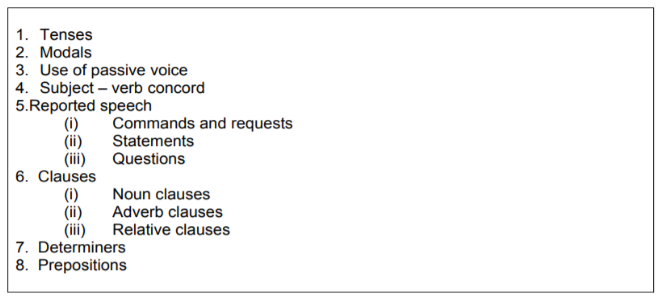
The above items may be tested through test types given below:
5.Cloze passage/ Gap Filling /Editing. 4 marks
6. Dialogue writing/Reporting a dialogue on a given cue. 6 marks
Section C
Literature Textbooks and Supplementary Reading Text
Marks 30
Internal choice will be there.
7. One out of two extracts from prose/poetry/drama for reference to context. Two Short Answer Type Questions on interpretation. 2x2= 4 marks
8. Five Short Answer Type Questions out of seven to be answered in 30-40 words each from FIRST FLIGHT and FOOTPRINTS WITHOUT FEET (three from FIRST FLIGHT and two from FOOTPRINTS WITHOUT FEET). 2x5=10 marks
9. One out of two Long Answer Type Questions from the book ‘FIRST FLIGHT’ to be answered in about 100-150 words each to assess creativity, imagination, and extrapolation beyond the text and across the texts. This can be a passage-based question taken from a situation/plot from the texts. 8 marks
10.One out of two Long Answer Type Question from the book ‘FOOTPRINTS WITHOUT FEET’ on theme or plot involving interpretation, extrapolation beyond the text and inference or character sketch to be answered in about 100-150 words. 8 marks

Hindi Syllabus for CBSE Class 10
CBSE Class 10 Hindi A Syllabus 2020-2021
The syllabus for class 10th CBSE for HINDI Course-A has been released on the official site of CBSE for the session 2020-2021. Students are advised to check the weightage of each section and prepare accordingly.
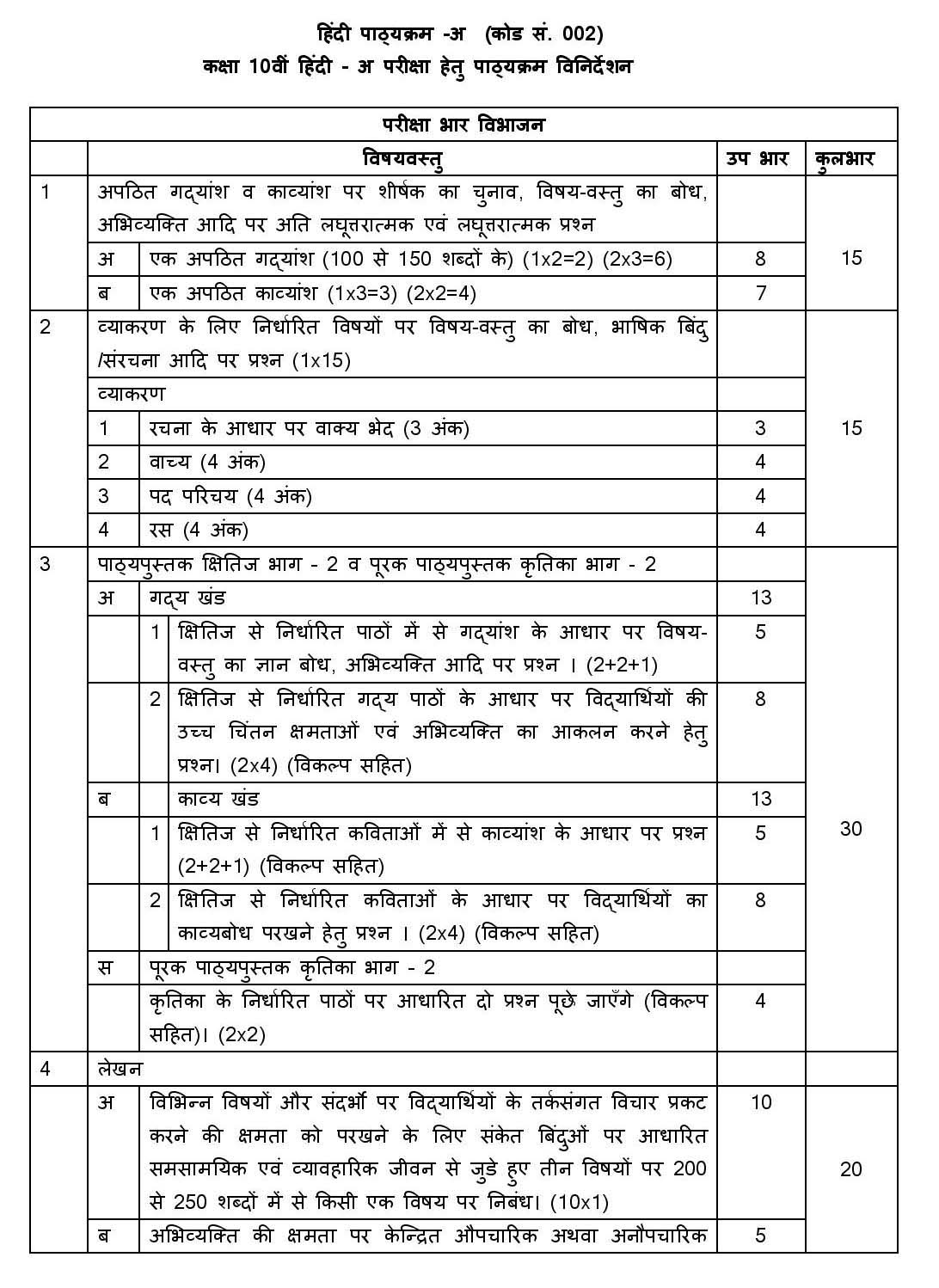
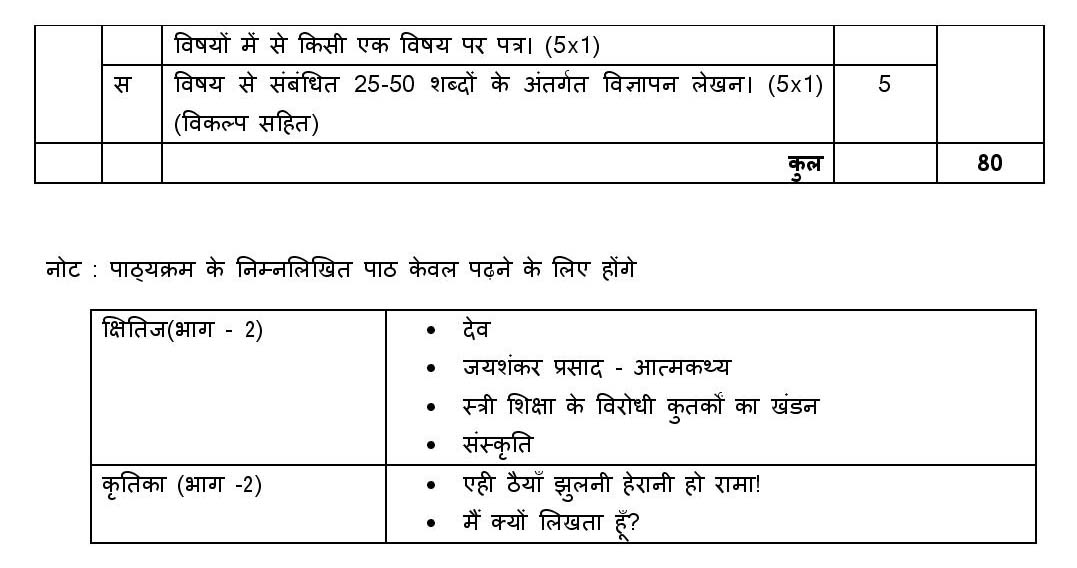
CBSE Class 10 Hindi B Syllabus 2020-2021
The syllabus for class 10th CBSE Hindi Course-B has been released on the official site of CBSE for the session 2020-2021. Students are advised to check the weightage of each section and prepare accordingly.
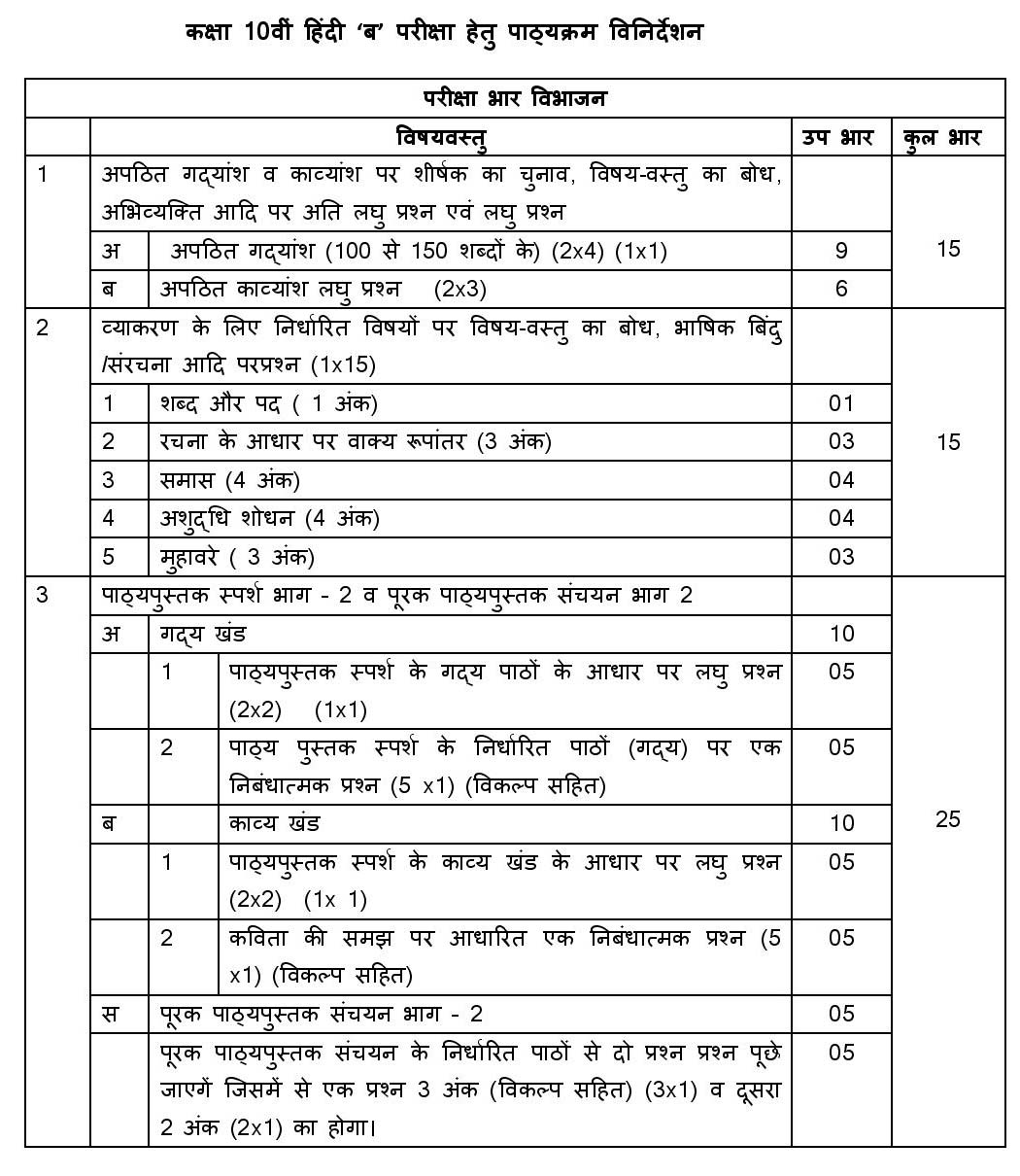
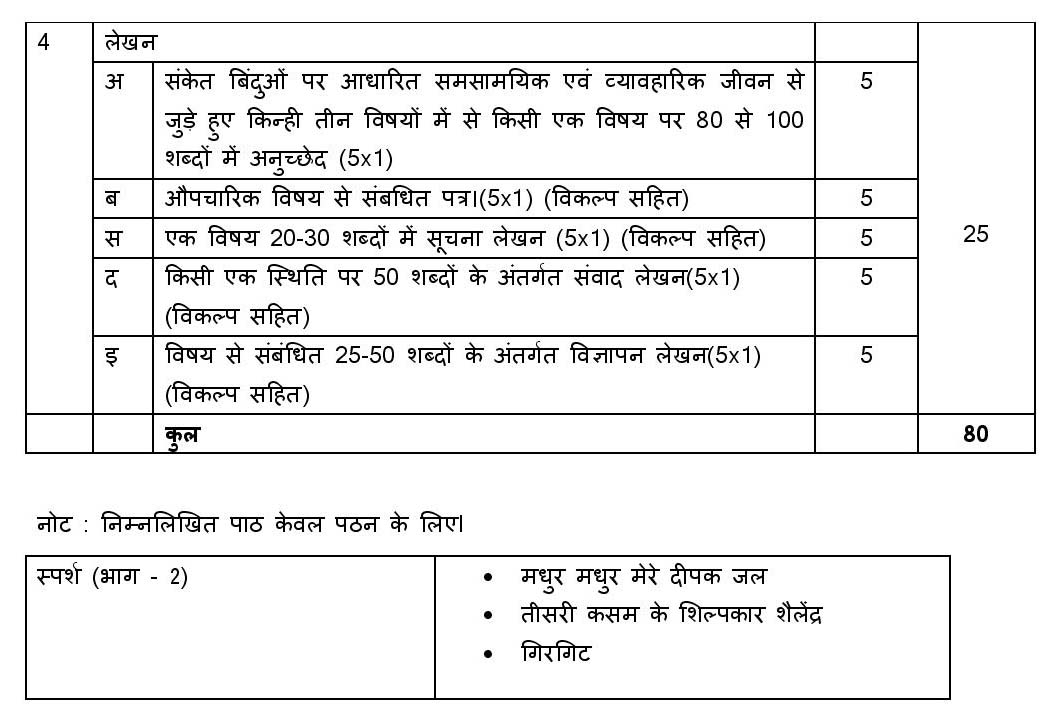

Information Technology Syllabus for CBSE Class 10
The syllabus for class 10th CBSE Computer Applications has been released on the official site of CBSE for the session 2020-2021. Students are advised to check the weightage of each section and prepare accordingly for theory along with practical.
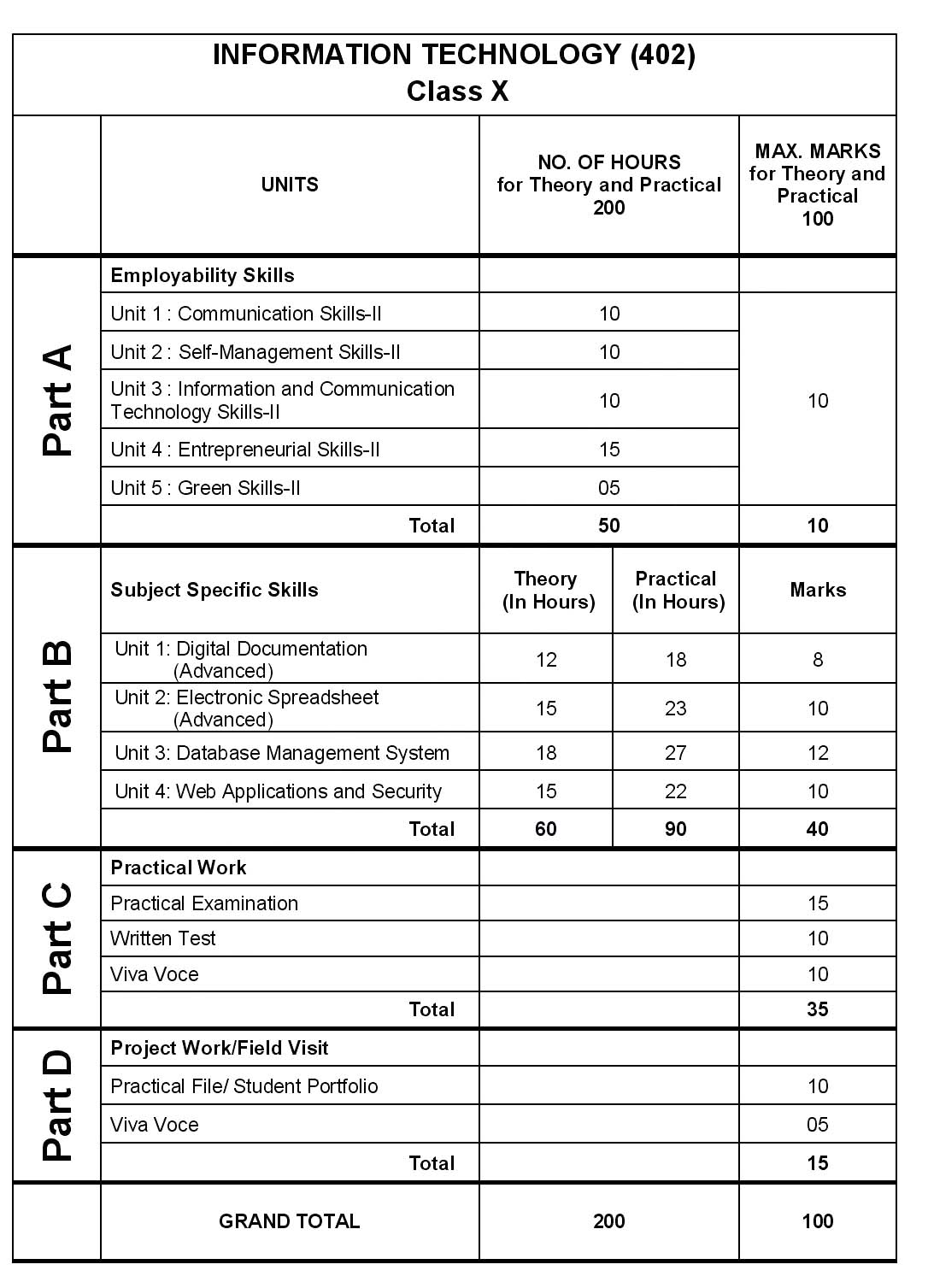
CBSE Class 10 Syllabus CheckList


Here we have attached a checklist for students to keep a check on their progress. They can note down the date when they start a chapter and when they complete it. They can also note down their doubts in a particular section and there is an added feature in this checklist is the revision column. That will help students to know their revision status chapter-wise.
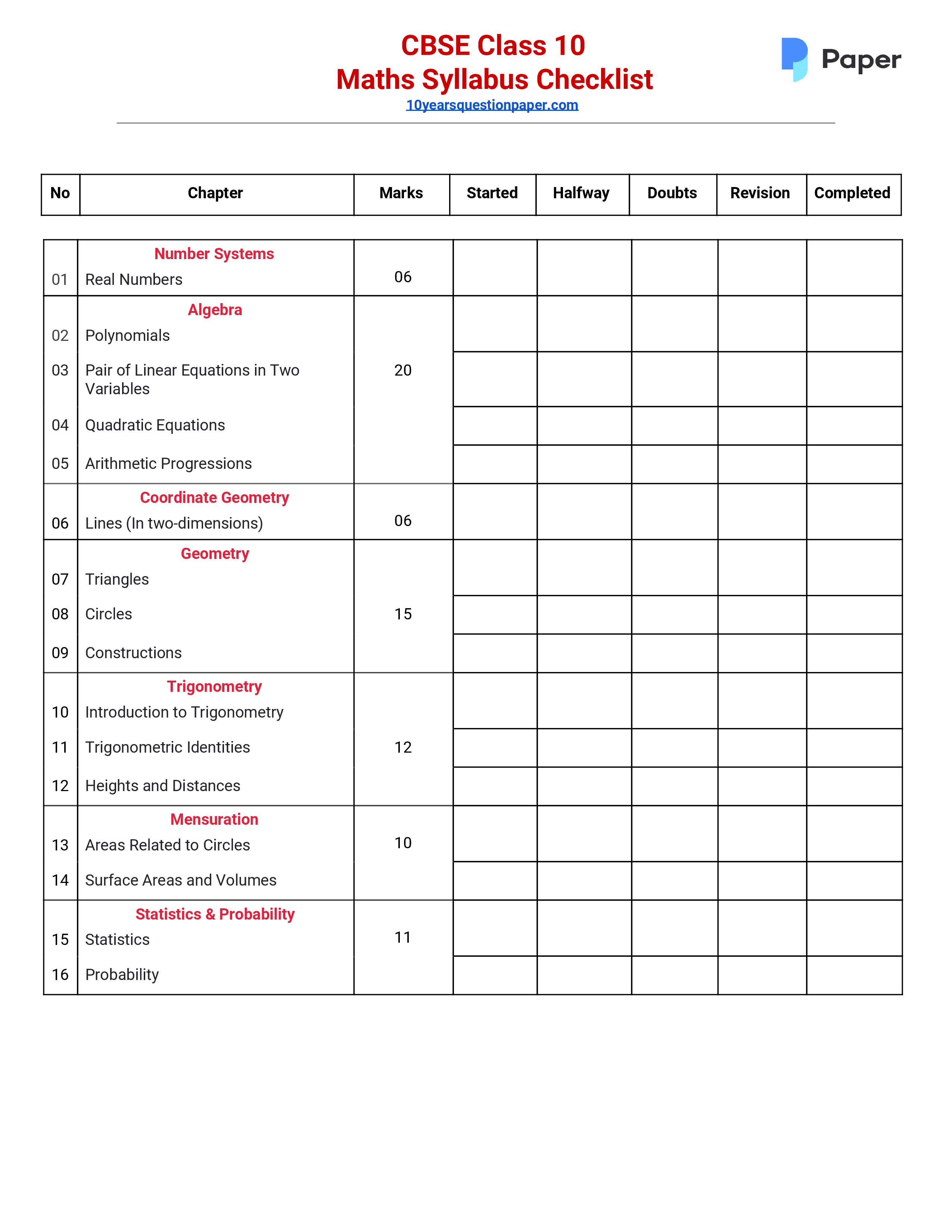
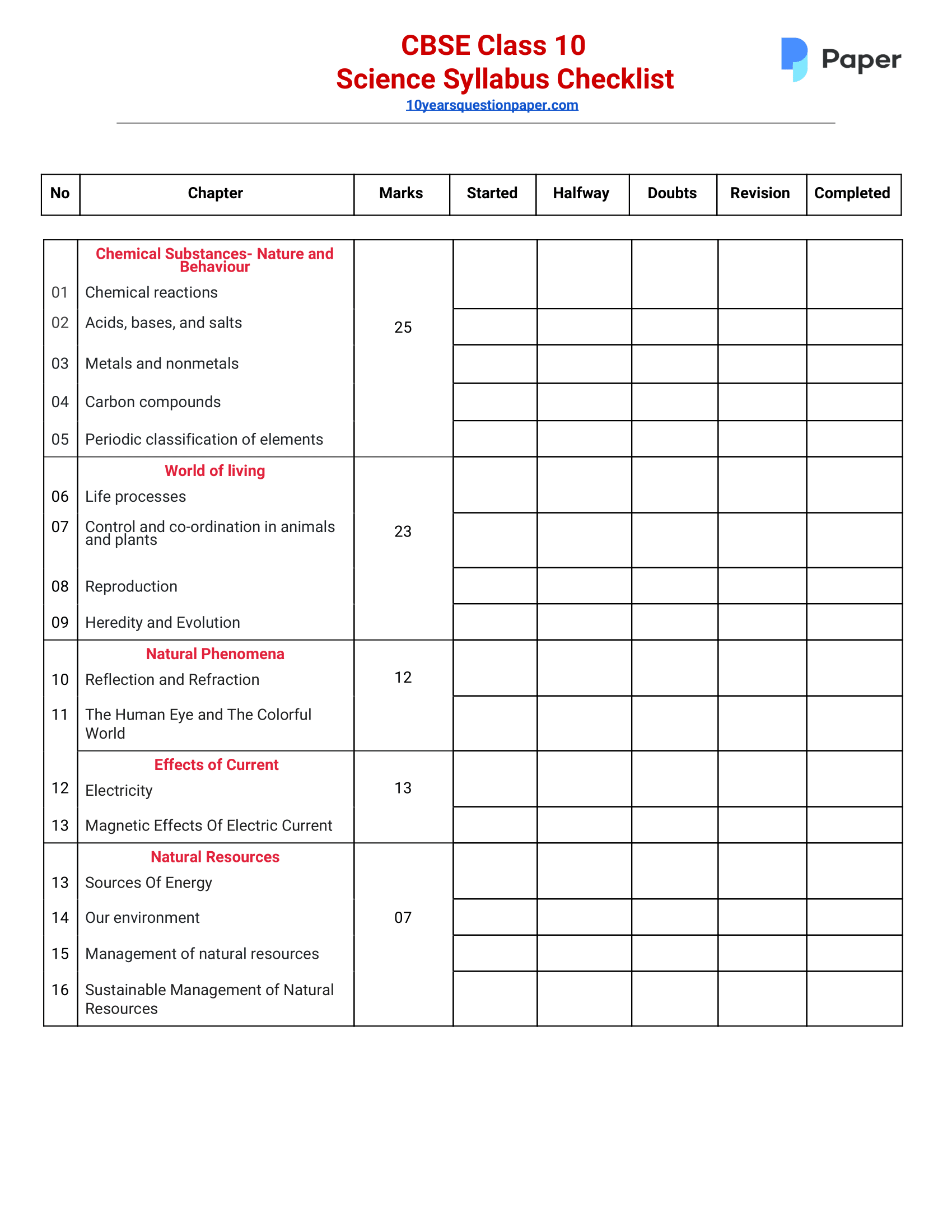
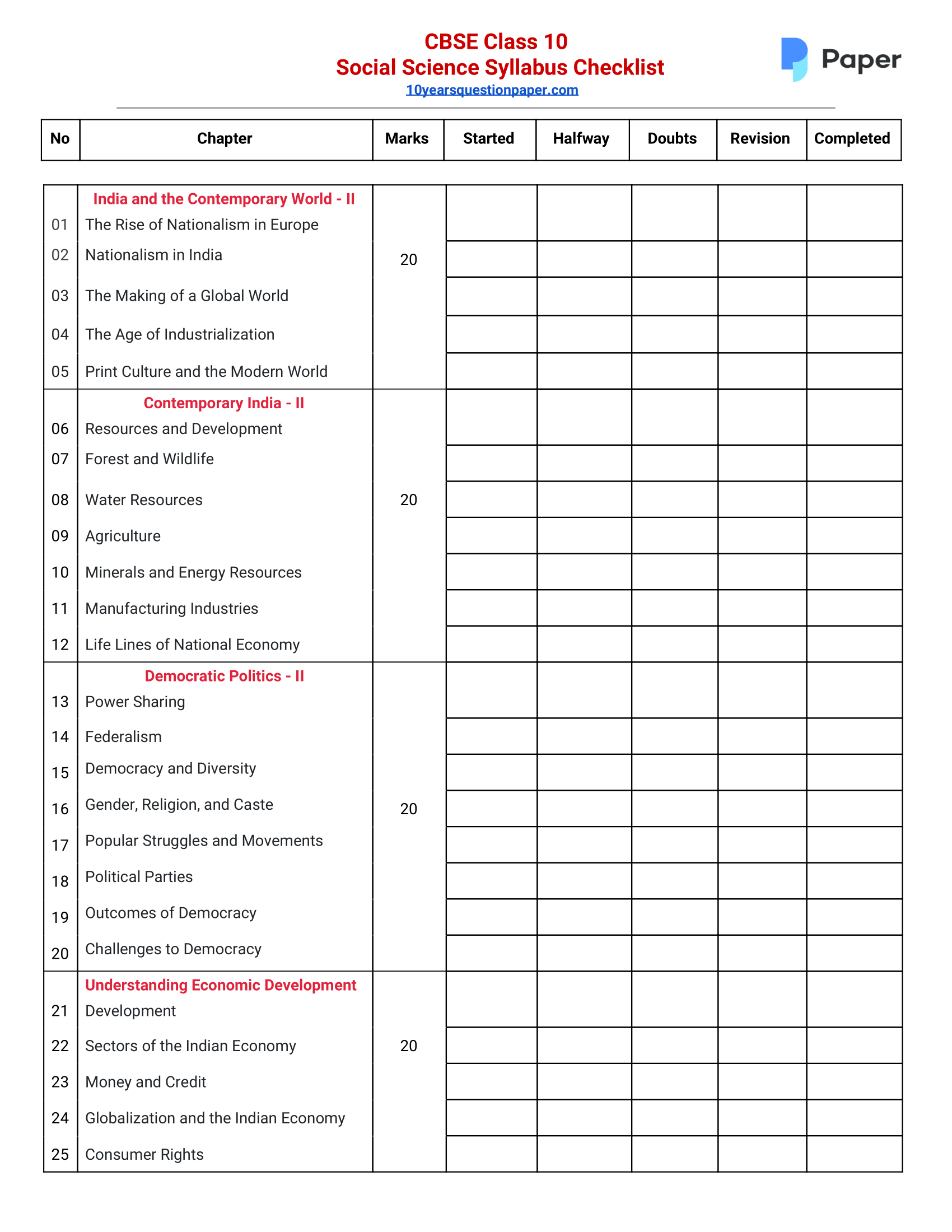
CBSE Class 10 Syllabus CheckList Download PDF
We hope right now students would be enjoying the quarantine period by playing indoor games and doing fun activities. But after seeing the class 10th syllabus they would definitely gear up to complete the portion before their board exams and keep ample time for revision and will practice the previous year question papers which are available on our site for free.
CBSE Class 10 Syllabus FAQ’s
Is Ncert enough for CBSE 10th Boards 2021?
The Central Board of Secondary Education (C.B.S.E.), through a circular, has urged all its students to prepare for the Board Exam 2021 according to the syllabus suggested by the board and not as in NCERT books.
What is the syllabus of CBSE Class 10?
The Class 10 CBSE Syllabus is designed by the board officials of CBSE and NCERT, which consists syllabus for all the main subjects like English, Hindi, Maths, Science, and Social Science. The CBSE Class 10 Syllabus gives you detailed information to cover in the particular unit along with unit-wise weightage Marks.
Syllabus Downloaded from www.cbse.nic.in.

Hey! So, have you start preparing according to the latest Curriculum CBSE Class 10?